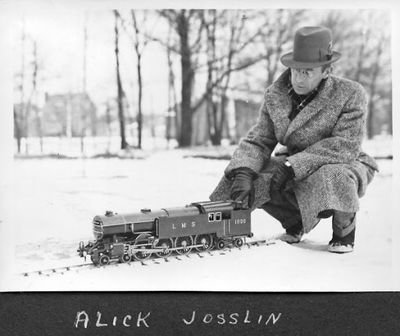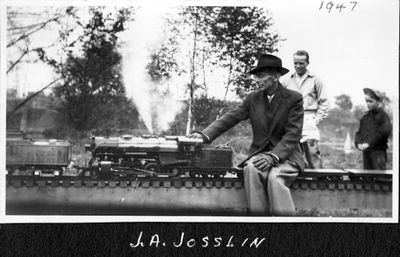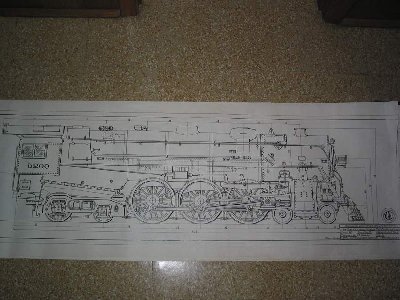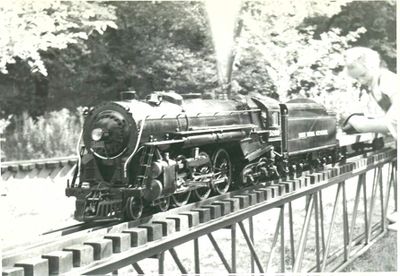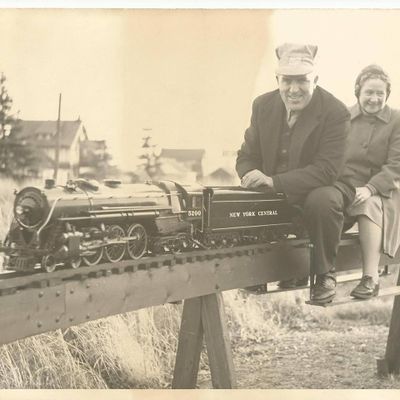James Alick Josslin
Jump to navigation
Jump to search
James Alick Josslin was the second President of TSME from 1934 to 1937.
Gallery
Alick Josslin and the original Helen Long 2.5 inch Gauge Locomotive constructed by LBSC for Josslin.
Josslin Hudson
- The drawings which I have are undated. There are 13 drawings altogether (A1 through A13) which are very detailed and follow the prototype closely. Like the Hoffman design, the Josslin design is for a NYC J1b Hudson. However, this drawing set is not complete. I think that these drawings are all that exist but if anyone knows better, then I would be very interested to know if something more is out there.
- On some of the drawings the initials P.E.H appear. I know that these initials stand for Percy Eldon Hunt who was Josslin's drafting partner. While I have found a lot of material relating to Josslin, I know next to nothing about Hunt although both men, Josslin and Hunt, lived here in Toronto.
- I obtained the Josslin Hudson drawings originally from Howard Hunt, Eldon's son although I did not know that at the time otherwise I would have asked about the history of both men's collaboration. It is ironic that the National 2-1/2 inch Gauge Association in the UK seems to have more information on Josslin and Hunt than we do here. Howard Hunt, I recently found out died in 1995.
- Again, if anyone knows anything about Hunt, I would be interested in any additional information which may be out there.
- Josslin and Hunt collaborated on and produced a number of 2-1/2 inch gauge model locomotive designs in the 1930's and 1940's which are kept by the National association although their collection is not quite complete either. These designs often reflected an amalgamation of both English and American locomotive practice at the time and do not reflect, in detail, any particular full size prototype that ever existed. The reason why the National Association have so much material is due to the fact that Josslin kept a postal address in England through which he marketed his and Hunt's designs. Hunt's Toronto address was given as his North American marketing agent. Josslin often returned to England where he met a number of model locomotive designers including LBSC.
- (James) Alex Josslin was born in England but lived in Canada. He worked here in Toronto at Dominion Bridge as a design draftsman doing structural design and detailing. He was a member and the second President of the Toronto Society of Model Engineers (TSME) from 1934 to 1937.
- Josslin also did model locomotive design/drafting work for LBSC and LBSC mentions Josslin in his writings of the period in The Model Engineer. If anyone cares to know how LBSC and Josslin met, one should refer to The Model Engineer, Volume 96, Number 2383 dated January 9, 1947. See also, The Model Engineer, September 19, 1946.
- The model drawings show Walchaerts valve gear. While all NYC Hudson locomotives were eventually converted to Baker valve gear, The first J1 series Hudson's came from ALCO in 1927 with Walchaerts valve gear. In the Stauffer book "Thoroughbreds" there is a photo of 5200 taken in 1939 with Walchaerts valve gear still on this locomotive. Therefore, historically, it is quite legitimate to model a 5200 series NYC Hudson with this valve gear.
- I don't want to start the battle of the valve gears but properly designed and constructed, I have been told that Walchaerts was a more precise valve gear and a better high speed valve gear than Baker. I like both and certainly after all of the work necessary to build the model, I won't be pressing the locomotive to do any high speed running on any model track.
- By the way, the Josslin boiler drawing shows the firebox crown sheet well above the centerline of the boiler barrel.
Norman Mottshaw's NYC J-1B (Josslin) Hudson locomotive at TSME Acres (Toronto Society of Model Engineers), circa 1950's.
Norman Mottshaw and his Josslin-designed NYC Hudson 5200 in 3/4 inch scale. Photo provided by Steve Bratina.
- The Mottshaw Hudson shown in the TSME historic photos I believe is 3/4 inch scale. Look at the leading truck wheels, they are sitting on the outer set of rails and not the inner set which was 2.5 inch gauge.
- The reason why the ties are so high up is because the locomotive is resting on the open web steel joists of the Robert Henham bridge named after the TSME President of the time (1942 -1948) in TSME Acres. TSME Acres was officially opened in the fall of 1945.
- The locomotive is numbered 5200. The Josslin Hudson drawings are numbered 5200. Also notice the line of rivets on the boiler firebox at the level of the mud ring. This is seen on the Josslin drawings exactly in this position which is unique to Josslin.
- Due to the above, the photo of the Mottshaw Hudson is, I believe, a Josslin Hudson and the only complete one I have ever see a photo of.
- The Josslin Hudson was first described in the Model Engineer in 1933 and Frank Birch was mentioned as being the supplier of castings for this locomotive. However, in the April, 1934 issue of The Modelmaker, there is an article (with photos) by a Mr. I. B. Kerr of Oslo, Norway who constructed a Josslin Hudson and who states that the castings for his model came from a Mr. C. Holt.
- My understanding is that Calvert Holt also had a very detailed NYC Hudson design in 3/4 inch scale but he only advertised completed locomotives for sale and never had any castings or drawings on offer.
Helen Long
- Helen Longish is going to be my version of Helen Long, the 4-8-4T tank locomotive jointly designed by LBSC and James Josslin. A brief construction series appeared in Model Engineer volumes 56 and 57. The loco was intended for the experienced builder and having read the articles I can see why! The construction notes and drawings are pretty vague and there seems to be a lot of discrepancies between the details. According to LBSC quite a few Helens were built but where are they all?
Alick Josslin and the original Helen Long 2.5 inch Gauge Locomotive constructed by LBSC for Josslin.
James Josslin driving his 2.5 inch gauge Helen Long locomotive officially opening TSME Acres 7 October 1945. Helen Long was one of the Josslin/LBSC designs.
